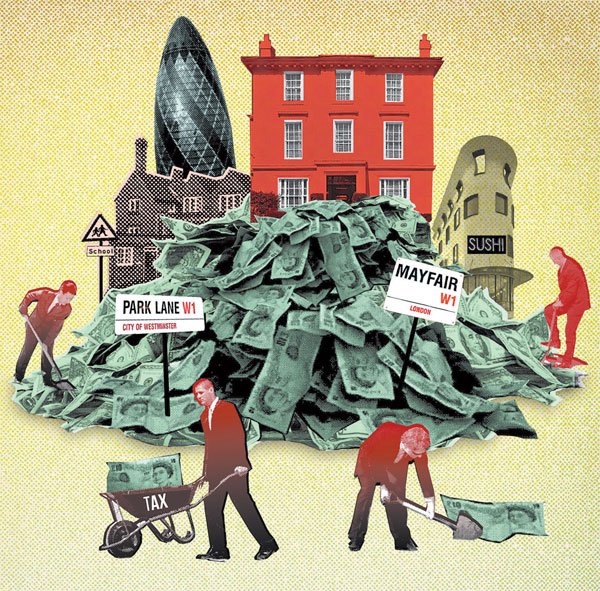
THE LAND QUESTION IN HISTORY
by Silvano Borruso
The Land Question acts as a background to every history book of every time and place. The less the author is aware of its importance as a determining cause of war, treaties, dynastic marriages, colonialism, papal elections, revolutions, capital executions and what have you, the more he reveals to the perceptive reader, and only to him, the drama when not the tragedy of land misdistribution.
I affirm the above because none of the authors by me consulted has shown awareness of the problem. The two that opened my eyes to it, Henry George (1839-1897) and Silvio Gesell (1862-1930) expound on the theory of the question, with unanswerable arguments. But their historical examples are scanty.
The purpose of this essay is to move the Land Question from the background to the foreground of history. It will not exhaust the topic for obvious reasons, but the examples chosen, or better bumped into, should be enough to stimulate further investigation for a possible future political action.
An indispensable preamble to understand the question is Adam Smith’s (1723–1790) following paragraph from The Wealth of Nations.
As soon as the land of any country has all become private property, the landlords, like all other men, love to reap where they never sowed, and demand a rent even for its natural produce. The wood of the forest, the grass of the field, and all the natural fruits of the earth, which, when land was in common, cost the labourer only the trouble of gathering them, come, even to him, to have an additional price fixed upon them. He must then pay for the licence to gather them; and he must give up to the landlord a portion of what his labour either collects or produces.[1]
As a good British pragmatist, Smiths stops at the facts. He takes it for granted that he who “loves to reap where he never sowed” has all the right to maximize the rent: either by lowering the wages of his labourers, or by increasing the rent of his tenants, or both where the size of the property allows. Let me open the argument with
Sicily
In my boyhood I had the privilege (understood decades later) of meeting Don Cola Tampuso, a grizzly shareholder on a small farm where he lived with his wife. Despite the fact that 50% of the fruits of his labour ended up in the pockets of one who “loved to reap where he never sowed”, he could make ends meet, for the farm was no more than a couple of kilometers from the nearest market. Had it been ten kilometers or more, the intermediaries would have taken most of his wages, leaving him with just enough to survive. The reader will have recognized David Ricardo’s (1772–1823) ‘iron law of wages’.
Let us make an effort to understand what happens when “the land of any country has all become private property”.
Fenced land originates a double sovereignty: that of Government, which shows it off with flag, military uniforms, national anthem, taxes and assorted decorations, and that of the landlord, who carefully refrains from showing anything, but exercises it de facto, as did the owner of Don Cola’s farm. Who, like all the marginalized in the power struggle (read landless), lived as a proletarian, surviving as well as he could.
Four consequences stem directly from the fencing off of land:
- Sooner or later the large estate replaces small, individual plots. The problem is that human nature has dictated individual diversity, so that the less able to run their property will not take long in selling it, to be incorporated into larger and larger units. This is one reason why no ‘agrarian reform’ based on fencing of land has ever succeeded.[2]
- Slavery is the natural, hence permanent, counterpart of land ownership. The large estate depresses the wages of those who work within it; land ownership per se depress the wages of those working on their own land, since it pushes the margin of cultivation farther and farther away from the centres of consumption, where it is more profitable to use land for purposes other than agricultural. Both are another reason for the failure of ‘agrarian reforms’: the distance between production and consumption renders the small property uneconomic.
- In order to maximize his rent, the ‘sovereign’ of the large estate must count on a pool of unemployed so as to keep wages down, and on tariffs to protect his prices from competition. He attains the first aim by keeping large tracts of his estate fallow, thus denying access to would be occupiers; and the second by manipulating public policy.
- As society gets increasingly divided into a powerful (but necessarily small) group of landlords and a large one of landless, it is the class war, which is not at all a Marxist invention: it is enough to read Livy to read about it. Bloodshed, whether in civil or in foreign wars provoked by those who intend to maintain their undue privileges at all costs, becomes inevitable. A treatise could be written, but let us stick to Sicily, especially in its last 200 years of its history.
Up to 1806 the law in force was that of the public commons (It. Demanio). It was a feudal institution, wisely reformed by Neapolitan law.
The Demanio’s raison d’être was to prevent landlords from usurping the king’s sovereignty over the land. It acted through a true plethora of local usages that regulated the use of land, impeding, or severely limiting abuse. The Don Colas of the time did not squander, but did not starve either; they cultivated small public parcels for private use, enough to eat, dress and have a roof over their heads, plus some extra to fulfil their obligations. There was no unemployment, and no emigration.
The Demanio was a paternalist institution, which aligned the sovereign to the people against opportunists desiring “to harvest where they had not sowed”. It was not equilibrium, but a contained disequilibrium, akin to a champagne cork clumsily used to stop a diarrhea.
The first blow to the system was delivered by the Murat laws of 1806–1808. With the abolition of feudal law, the landlords enjoyed living off rent for more than 40 years. The lion had tasted human blood.
The revolutionary riots, as elsewhere, were not “people’s” doing, but the work of those who foresaw the possibility of living at the expense of others. The poor were robbed of even the furniture used for the barricades of 1848.
King Ferdinand II almost gained the struggle, but not for long. Not only did he repeal the constitution, but between 1850 and 1854 he also returned to the common lands more than 100,000 units of land usurped by the Murat crowd in the kingdom.
It is not therefore surprising that such people should howl against “Bourbon tyranny” while cheering Garibaldi and the Piedmontese as “liberators”; which they were, but not of the people drummed up in history textbooks.
In 1860 unemployment and famine arrived together. What to do with the sudden increase of proletarian men, women and children?
There was only the embarrassment of choice: from Swift’s (1667-1745) Modest Proposal, i.e. serving the poor’s babies as dainties for the rich people’s table, to Malthus’ (1766-1834, still taken seriously) convincing them to breed less; to the Terror, which had the hidden purpose of curbing the population of France;[3] to transportation of surplus Irish to Australia even for the theft of a handkerchief, to compulsory military service for thousands of unemployed transformed into cannon fodder, to easy incarceration (The US have almost three million, about 1% of the population). The Piedmontese opted for the firing squad, with which they killed two birds with one stone: getting rid of the surplus proletariat at home and forcing the rest to migrate.
And so Sicily ‘enjoys’ (if it is the right word) this system of land tenure to date. The liberal principle “everyone after himself and the devil take the hindmost” has worked. In 1960, 100 years after the ‘liberation’ the elderly father of two sons who had run away from the island was interviewed:
The children run away, to Germany, to Turin. I don’t deny it: when my son worked with me, and needed 100 lire for a shave, he didn’t have them. The other son also ran away, together with many others. There was no progress, there was no land. All of us worked like slaves, and today even more, with no satisfaction whatever. I think that if no one does anything, in Sicily, everything will come to an end. It’s not that we die of hunger, but everything is dry; no one grows anything. People are content with arriving at the pension and no longer having to work. The rule is: little is enough and a lot is surplus. Formerly I was badly off, so I am now, but at least now I don’t do anything.[4]
In 1992 I had the opportunity of visiting the island’s interior. The only economic activity observed was a shepherd with his herd of cows for a distance of some 100 km.
Ever since, things have gone from bad to worse. To the series fencing>large estate>class struggle>war only the last is missing. I only say that the 2.5 million hectares of the territory remain fiscally sterile for the State, who in turn is bent into extorting the fruits of citizens’ labour. The landlords, who exercise real sovereignty, have sung victory, and it is not necessary to be a prophet to foretell that sooner or later the situation will turn violent.
Kenya (ex British East Africa)
Sicily and Kenya are 5000 km apart. What unites them, in this essay, is my person, born in the first and living in the second. The difference, observed personally, consists in the rivers of blood that in Kenya decorate the newspapers with monotonous regularity.
The “patched-up beggar’s overcoat” to which the political map of Africa resembles[5] divides the continent into some 50 of what fuzzy thinking calls ‘nations’. Then one learns, at school, that each African ‘nation’ is home to hundreds of ‘tribes’ which the European Great Powers ‘pacified’ after the 1885 Berlin Congress, and which after independence (1956-to date) do nothing except massacring one another.
The reality, nevertheless, is different. If we define ‘nation’ as “a people of homogeneous usages and customs”, Africa sports about one thousand of such. Some attain respectable size: the Igbo of Nigerian sum up to 30 million, more than Scandinavian and Belgians together. But they are still dubbed ‘tribe’, forgetting that the first user of that term was Servius Tullius sixth king of Rome, who divided the Urbs into four tributary districts (hence the term). How and when the same term was foisted on the African nations I have been unable to discover.
If therefore among members of such nations, at times after decades of peacefully coexistence including intermarriage, orgies of destruction and death explode unchecked, there must be some cause other than ethnic differences, and so it is.
The Title Deed
Smith’s paragraph reproduced earlier exhibits a social abscess about to burst already in his days after a couple of centuries of incubation: the expulsion of the proud English yeomen from the lands they had cultivated for centuries, and which King Henry VIII’s greed had sold to the nouveaux riches in exchange for ‘title deeds’. At the beginning the expellees took refuge in the common lands of the Crown, but at the end of the 18th century the landlords enclosed even these. The landless yeomen would have starved to death had the Industrial Revolution not saved them with starvation wages it’s true, but wages nonetheless, which allowed them to survive.
The landless descendants of the victims of that original injustice directed their attention towards expropriating African nations. The Spanish landless had done the same with American nations at a time when Spain numbered scarcely nine million people, but whose lands had been grabbed by landlords as powerful as their English counterparts. Englishmen and Spaniards colonized for being militarily strong peoples; Italians and the Irish, militarily weak, migrated to North America in search of fortune. But the surreptitious drive behind the four was the same: the new landlords, with their ‘title deeds’ and supported by military might, had forced the landless either to starve to death or to emigrate. Behind each ‘title’ issued by an authority, English, Spanish or Piedmontese, there had always been an act of violence.
At the Root
All ancient cultures, without exception, had developed a communal system of land tenure. We have seen one, in force in the Kingdom of the Two Sicilies up to 1860.
There is a natural reason for it, and therefore one of common sense: land a) is not man-made and b) is immortal. It follows that property of land is communal by natural law, since a community is as immortal as the land on which it is settled. An individual landed property is a juridical construct in that it grants an unjust privilege to a mortal, authorizing him to call ‘mine’ something for which he has not worked and which one day willy-nilly he will have to leave behind.
It is true that such a privilege may be mitigated by extra duties assumed by the landlord. It happened during the seven centuries of feudal tenure. The ecclesiastical landlords assumed the burden of social security; the secular ones that of administration and defense. The same could happen today if the landlord disbursed a rent for the occupation of a certain surface, but left to enjoy the fruits of his labor. This would be akin to extending the parking fee system as practices in the centre of a crowded city, where a vehicle pays a fixed daily sum to occupy a parking bay in exclusive. If the law authorized the first occupier to sell the title deed (the ticket) to the next one, the municipality would lose the parking revenue.
If the same law that allows a municipality to charge rent for a parking bay was extended to buildings ‘parked’ permanently, at the same rate as the cars, i.e. so many $ per square foot per day, the surplus of municipal revenue could be conveyed to the State as State revenue, and the surplus of the State to the Federal Government.[6] Such sums could cover a large amount (all according to Henry George) of State expenditure. The State would not have to employ an army of officials with draconian powers of confiscation of the fruits of labor, and the economy would unshackle itself of the impediments that prevent it from taking off.
With the ‘title deed’ the situation is reversed. When a landlord sells his land to another, the sum corresponding to the bare ground, which in justice should go to the community for having created that value, goes to his pockets instead. Such a situation, which passes unnoticed in Europe after centuries of bureaucratic somnolence, in Africa has lethal effects, as we shall soon see.
To prove that at the origin of every ‘title’ granted to an individual (hence unnatural) there is an act of violence, from military conquest to murder, it is enough to read any case anywhere in the world.
The following case occurred in 1999 in Louisiana. The applicant for a loan from the Federal Housing Authority had offered his title deed as collateral. His lawyer had traced the origin of the title to 1803. The FHA was not satisfied, and demanded that it be tracked down “to the origin.”
The annoyed lawyer responded:
[…] I was unaware that any educated person in this country, particularly those working in the property area, would not know that Louisiana was purchased by the US from France in 1803, the year of origin identified in our application. For the edification of uninformed FHA bureaucrats the title to the land prior to US ownership was obtained from France, which had acquired it by Right of Conquest from Spain. The land came into possession of Spain by Right of Discovery made in the year 1492 by a sea captain named Christopher Columbus, who had been granted the privilege of seeking a new route to India by the then reigning monarch Isabella. The good queen being a pious woman, and careful about titles almost as much as the FHA, took the precaution of securing the blessing of the Pope before she sold her jewels to fund Columbus’ expedition. Now the Pope, as I’m sure you know, is the emissary of Jesus Christ the Son of God. And God it is commonly accepted created this world. Therefore I believe it is safe to presume that He also made that part of the world called Louisiana. He therefore would be the owner of origin. I hope to hell you find His original claim to be satisfactory. Now may we have our damn loan?[7]
They got it. Now, what does Louisiana have to do with Kenya? It does, because the key point is the same. A title deed is worth neither more nor less than the physical force needed to defend it. When the landlord is the State, its power over the ‘national’ territory depends on its armed forces; but when the landlord is an individual, and disarmed as he is in Kenya, the security of the title depends on the capacity and willingness of the armed forces of the State to defend it.
What happened in Kenya in the first days of 2008 was but a bloody tail of a series of casualties for more than 50 years, which flows as a river every now and then. Starting with the Mau Mau revolt of the 1950s, tens of thousands of units of human capital and millions of man-hours of useful work have been immolated on the altar of an idol called ‘title deed’.
The history of this particular idol is a long one. It got enthroned by King Henry VIII of England (1509-1547), and was imported into Kenya by the not so enlightened descendants of the ex-yeomen rendered landless by the devastations of the same idol. What would have happened if the British colonialists had applied in Kenya a truly enlightened, peaceful system of land tenure, instead of an obscurantist and violent one?
A Possible Solution
It is true that history is not made of ifs and buts, but some speculation is in order. Suppose that the colonial government, instead of issuing title deeds to each White settler, had fixed boundaries for each nation/tribe already existing, guaranteeing security by means of its armed forces. Only then the same government would have issued a title to each community in exchange for a fixed rent to defray the expenses of armed protection and administration. Each White settler would have then paid rent to the community, which would have protected the occupation in terms of a contract with the force of law before the colonial government.
The rent would have varied according to location and density of population. No fruits of anyone’s labour would have had to be extorted, with the desirable result that the more the wealth produced within the limits of the community, the less the fixed tribute to the government would have burdened it. Furthermore, a low-wage policy would not have been possible, for the option whether to work for oneself or for a settler would have been left open.
A virtuous circle would have resulted. The White settlers then and the Black ones now, instead of being perceived as intruders and therefore exploiters, would have been perceived, and up to now, as sources of wealth and of public revenue, directly to the community an indirectly to the State.
It didn’t happen. When the forces of the Crown left, so did the White settlers, and with them a huge stock of fixed capital created in half a century of hard work.
That the above is not utopia is shown by two facts.
First: in Kenya, a dozen or so White settlers still operate in the country, but without ‘title deeds’. Instead they pay rent to the Maasai, who in exchange protect their properties.
Second: in Zambia, half way between Kenya and South Africa, freehold title deeds were abolished in 1975. Former Crown Lands are in the hands not of the State but of the President, who grants it to anyone willing to pay a modest ground rent on a 99-year lease.
I personally verified the results of this policy in 2012. Lusaka, the capital city, sports double carriage ways, a total absence of traffic jams, free and ample parking anywhere, bungalows instead of apartment blocks, and a well-regulated public transport entirely in private hands. But what is more, not a single drop of blood has been spilled over land disputes since 1975.
And not only: some 120 White settlers expelled from Zimbabwe cultivate land in Zambia, thus contributing to the national economy with their skills and know-how.
In Kenya the story has been very different. Its first President (1963-1978) belonged to the Kikuyu nation. Sagaciously, he realized that a democracy founded on the party system would have been ruinous for a multinational country.[8] His single party policy had cost limiting certain liberties, but did preserve social peace until his death.
Here it is necessary to understand the Kikuyu. They are a people of tireless, active ants, able and willing to run – and shoulder – risks. They do not hesitate migrating to the ends of the earth, from Scotland to Japan, and prosper. Strong of more or less four million, they had been exiting since independence from the 13,000 square kilometers of their native province to migrate within Kenya, settling on lands of other nations. Working as they usually do, they became the wealthier, the more they settled among nations of less enterprising people.
The President, as is natural, had favoured their emigration, granting them, you guess, ill-famed ‘title deeds’ on foreign lands. It was a time bomb, considering the morbid attachment of all African societies to their ancestral lands. It could last only as long as the armed forces were in a position to defend such titles.
The second President (1978-2002), a non-Kikuyu, succeeded in keeping the peace until 1988, when the Western paladins of Democracy put pressure on him to accept the multiparty system, outside of which, as is well known, there is only weeping and gnashing of teeth.
Since African parties lack ‘programs’, ‘manifestoes’ and like tackle, electors always vote for one of their own, whose fixed ‘program’ is, “I want to be President”.
Hence when the 1992 elections loomed near, the President realized that had he left the Kikuyu in peace where they had settled, they would have voted against him. And so he organized what the Western Press called “local clashes” but which in reality were operations of ethnic cleansing aimed at chasing Kikuyu farmers from non-Kikuyu areas.
He succeeded twice, 1992 and 1997. Round figures as to the number of dead and the amount of wealth destroyed are still missing.
In 2002 a coalition of Kikuyu and other nations fed up with a presidential power greater than that of any Louis XIV, succeeded in voting him out of office and installed another Kikuyu as President.
But when the electors of 2007 threw out of office 22 out of 27 ministers of the incumbent administration, it was clear that the opposition was going to win.
History teaches, however, how easy it is to rig elections from the centres of power. And so it was. The bomb went off within ten minutes of announcing the results. This time the country split dramatically into two. A totally irrational ethnic cleansing sank the country into a bloodbath, lit up by tragic bonfires of destroyed property.
The final toll was 1300 dead, a yet unclear number of maimed and wounded, and 300,000 or so homeless. A visible minority still lives in refugee camps, showing off utterly useless ‘title deeds’.
Western television broadcast hair-raising images, showing but a partial aspect of reality. Which, hidden under a thick blanket of disinformation, showed its true face only to those in the know: the Land Question, still unsolved in a Third Millennium well on its way.
A Double Crown
In the history of ecclesiastical institutions, from the papacy downwards, the Land Question occupies a preponderant place, but like the elephant in the room, it passes unnoticed until someone points it out. Having read George and Gesell one indeed notices.
The Edict of Thessalonica (380) imposed the public confession of the Christian faith on the Empire. As a consequence, donations of land began to accrue, not to ‘the Church’ as embedded historians like repeating, but to flesh-and-blood popes, bishops and priests, who benefited from the rent of such lands.
But, like everything else in this world, land rent was put to two very different uses. One, benevolent, financed a thick network of social services: health, education, poor centres, orphan homes, hostelry, etc. all free of charge, which rendered taxation by the civil authorities superfluous. The other, malevolent, use of the same rent was, you guess, diverting it for uses not always edifying to put it mildly. Many members of the hierarchy, not to speak of intruders, could thus live in leisure (and worse).
It would take us too far to analyze 17 centuries of ecclesiastical land question. Let us concentrate on the donation of former Byzantine lands by Pepin of Heristal (756), which became the Papal States. They imposed a second crown on the pope: besides being head of the Church he was now King of those States. The arrangement lasted for more than 1000 years, until their demise in 1870.
The episode that I consider most grotesque was the war waged by His Most Catholic Majesty Philip II of Spain on the Sovereign of the Papal States, i.e. Pope Paul IV in 1556, to wrest from him the duchy of Paliano, today an insignificant municipality of Lazio.
Paul Johnson (1928- ) thus sings the praises of the ‘title deed’:
The freehold was unknown to barbarian Europe; indeed, it was only imperfectly developed in imperial Rome and Byzantium. The church needed it for the security of its own properties and wrote it into the law codes it processed – wrote it, indeed, so indelibly that the freehold survived and defied the superimposed forms of feudalism. The instrument of the land deed or charter, giving absolute possession of land to a private individual or private corporation, is one of the great inventions of human history. Taken in conjunction with the notion of the rule of law, it is economically and politically a very important one. For once an individual can own land absolutely, without social or economic qualification, and once his right in that land is protected – even against the state – by the rule of law, he has true security of property.”[9]
Johnson reduces, as many do, the Church to its hierarchy. What the ‘title’ really did was to split the hierarchy of the Church into high and low clergy, the first living off rent and the second as best it could, from alms begging to intrigue. To say nothing of priests who squandered huge amounts of time rent-seeking and hunting for benefices instead of fulfilling the duties of office. Let us also leave aside the infamous struggle for the investitures, which saw scoundrels of all kinds fraudulently ordained priests to accede to a ‘benefice’. A treatise could be written on this paragraph, but not here.
The ecclesiastical balance in land, as the one in Naples, was not at all stable, despite an appearance of centuries. It was a contained imbalance lasting until the sovereigns agreed to be controlled from above, i.e. by the Decalogue, and from below, i.e. by the social usages of a thick cobweb of guilds, confraternities and local authorities, towards whose liberties they swore allegiance. I will limit my analysis to Tudor England in the three years 1536-1539.
It is most impressive to read in Cobbett’s History of the Reformation in England and Ireland (but only if one has read George and Gesell) how a social security set up by 1000 monasteries and 10,000 monks during 900 years collapsed in three short years at the hands of Thomas Cromwell, lackey of Henry VIII. Cromwell made a lavish use of gunpowder (in the absence of dynamite) to demolish the great abbeys, the ruins of which still majestically dot the English countryside.
What happened to the land? The Lords grabbed it, hand in glove with the newly appointed prelates of the Anglican Church. Their descendants, even today, care not a fig about social security. They go on pocketing rents, “loving to harvest where they never sowed”. For the uninformed, no Labour Party has ever succeeded in getting rid of the House of Lords, despite repeated promises to the contrary in election time. The House of Lords exists precisely to prevent the Commons from upsetting the apple cart, i.e. the territorial privileges secured by their ancestors with the simple subterfuge of apostatizing from Rome to take refuge in Westminster. So much for “one of the great inventions of human history”.
Byzantium
For reasons more or less unknown, the history of Imperial Byzantium rarely makes it into school textbooks, despite a venerable life of more than 1000 years. And no textbook links the fortunes of the Empire to the Land Question.
Reading between the lines, however, the question stands out in no uncertain terms. The dynasty of the Heraclids, from early in the seventh century, had to cope with a drastic depopulation caused by the Gothic wars of Justinian 100 years before. They stanched the bleeding by enticing or forcing people of Slav stock into the empire, Hellenizing them and organizing them into themata.
A thema was a territorial, fiscal and military unit with land security guaranteed not by ‘titles’ but by communal control. Every farmer was also a soldier, under the command of the Katapanos. He was fighting for family and home, and therefore with absolute loyalty. By solving the Land Question, the Byzantine Empire became invincible on the battlefield. And when the ‘title deed’ took over, defeat loomed on the same battlefield.
The topic is worth pursuing, but not in this short essay.
The Large Landed Estate Deletes Poland from the Map
A surprise awaits anyone perusing an early 17th century map of Europe. Its largest country was the then Lithuano-Polish Federation (Rzeczpospolita Polska). Its 773,000 square kilometers (Iberian Peninsula + Ireland + Iceland) extended north-south from the Baltic Sea to close to the Black Sea, and east-west from Silesia to 200 km beyond the Dnieper. But a good 60% of the people within those borders included a considerable population of Cossacks, Tatars and other groups neither Polish nor Lithuanian. The political stability of the Federation depended heavily, if not exclusively, on how the powers of the State dealt with the non-Polish non-Lithuanian majority.
The problem was that the landlords in power, ignorant of history, repeated with Poland the mistakes of Rome, albeit on a reduced scale. The eastward expansion entailed adding land to immense large estates, some of them the size of Switzerland or of Holland. Such estates generated, as they always do, forms of slavery. But the slaves sooner or later rebel, increasingly reluctant to defend lands that are liabilities to them and assets for others.
Wherever one looks: Rome, Greece, Ireland, England, etc., the parameters are always the same. With the same monotony, the population that should have defended the territory became a rural proletariat, with civic rights but landless. The only opportunity offered them was to work as day labourers in the great estates owned by the nobles, who extended their own power by extending their properties.
How noxious the large landed estate was for the common good could be verified for centuries with the institution of the liberum veto in the Sejm (Parliament). A single landlord had the power to veto any parliamentary intervention that he deemed contrary to the interests of his thousands, when not millions, of hectares. Necessary reforms were paralyzed, and the country progressively weakened.
The subject people, on the other hand, had land but not civil rights, to which they aspired.
In 1633 the Sejim approved a law that prohibited the nobles to trade, especially in alcoholic drinks. From that moment they began to live exclusively off rent, extorted more or less violently from the rural proletariat. Tax farmers were invariably Jews, immigrants in most tolerant Poland (which had no Inquisition) during the previous five centuries. 15% of Jews collected taxes in the towns, 85% in the countryside.
The vicious circle began with imported Jewish capital, which benefited the nobility as much as the State. Strengthened by such apparent advantage, Poland pushed her colonization increasingly eastwards. The tax collectors quickly realized that besides increasing the political power of the nobility, they could increase their businesses by pushing independent cultivators into a corner, causing their bankrupt and adding their properties to those of the nobility.
At the death of King Sigismund (1572) the Federation had extended its dominion over the Cossacks of southern Ukraine, who agreed to form part of Poland much against their wishes, also because as Eastern Orthodox they objected to being submitted to religious regulations alien to their culture.
A reform was called for. The Cossacks were promised a law that would give them the same rights as the Poles, as well as protect them against the vexations of the tax collectors and those of the Jesuits, both extremely unpopular in the territory.
The bill was discussed in the Sejm in 1648, the year of Westphalia. But the landlords, in cahoots with the tax collectors and putting their interests ahead of the common good, quashed the legislation.
The optimist waiting of the Cossacks became vehement indignation. Their hetman was Bogdan Chmielnicki. The tax collector Zachariah Sabilenski played a dirty trick on him, helping the Polish landlord Czaplinski to grab not only Chmielnicki’s land but also his wife. Another tax collector reported his negotiations with the Tatars to the government.
It was the last straw. After two audiences with the king, and seeing justice denied, Chmielnicki raised an army of Cossacks and Tatars, and inflicted a double, bitter defeat on the federal army, on 16th and 26th May 1648. There followed an orgy of looting, killings and massacres, which left behind mountains of corpses without distinction of age or sex.[10]
When dictating conditions, Chmienicki invariably demanded the expulsion of the Jews and of the Catholic Church from the territories under his control.
The neighbouring powers lost no time in realizing that the Polish colossus was a giant with feet of clay. Muscovy, Prussia, Sweden, Brandenburg and the Ottoman Empire started nibbling at Federal territory as weak as it was big in size.
In 1772 a Russian army and a Prussian one invaded the Rzeczpospolita Polska, crushing a desperate but useless Polish-Lithuanian resistance. Twenty years later Austria-Hungary joined them, and the partitions of 1793-95 completed the operation. Poland disappeared until the Treaty of Versailles of 1919.
The Poles still remember the disaster. They call it “The Flood”.
Conventional historians and artists keep busy representing the “Alliance of the three Black Eagles” (Russia, Prussia and Austria), at times adding picaresque details like Stanislaus Augustus Poniatowski last king of Poland as the lover of Catherine II of Russia, but none of them perceives the large landed estate as the remote cause of the partition. And the infamous ‘title deed’ goes on decorating textbooks as “one of the great inventions of human history”.
Silvano Borruso
silvano.borruso@gmail.com
25th September 2013
[1] The Wealth of Nations, Penguin 1985, pp.152-53
[2] This phenomenon was repeated in Kenya in September 2013. The President gave title deeds to a slew of landless, in a populist move after years of complaining. Within a week, many of the new owners had started selling their land for ready cash.
[3] Nesta Webster (1876-1960) affirms this in her World Revolution.
[4] Small nameless interviewee, c. 1960.
[5] I owe the happy expression to Silvio Gesell (1862-1930).
[6] There is scope here for suggesting a drastic pruning of extortionate taxation, but not here.
[7] Email received 19th November 1999, unreferenced.
[8] Antonio Rosmini (1797-1855) and John Stuart Mill (1806-1873) had said the same thing 150 years earlier.
[9] Is there a moral basis for Capitalism? American Enterprise Institute 1980, p. 52. Italics in the original. Bold type mine.
[10] Graetz (History of the Jews) estimates 100,000 casualties. The Jewish Encyclopaedia triples the figure.









